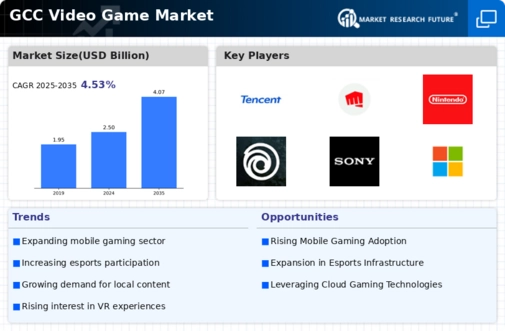Investment in Game Development
Investment in game development within the GCC is witnessing a notable increase, contributing positively to the video game market. Governments in the region are actively promoting the gaming sector as part of their economic diversification strategies. For instance, initiatives aimed at supporting local developers and studios are emerging, with funding opportunities and incentives being offered. In 2025, the total investment in the gaming sector in the GCC is projected to reach approximately $1 billion, reflecting a growing recognition of the industry's potential. This influx of capital is likely to lead to the creation of innovative and culturally relevant games that resonate with local audiences. Furthermore, partnerships between local developers and international gaming companies are becoming more common, enhancing the quality and diversity of games available in the video game market.
Rise of Online Multiplayer Gaming
The rise of online multiplayer gaming is significantly influencing the video game market in the GCC. As internet connectivity improves, more gamers are engaging in online multiplayer experiences, which foster social interaction and competition. Recent data indicates that over 70% of gamers in the region participate in online multiplayer games, highlighting a shift in gaming preferences. This trend is further supported by the popularity of battle royale and team-based games, which have gained substantial traction among players. The social aspect of online gaming is particularly appealing to younger audiences, as it allows for collaboration and competition with peers. Consequently, game developers are increasingly focusing on creating multiplayer experiences, which is likely to drive sales and engagement within the video game market.
Youth Demographics and Engagement
The demographic landscape in the GCC is notably youthful, with a significant portion of the population under the age of 30. This demographic trend is a crucial driver for the video game market, as younger individuals are more inclined to engage with digital entertainment. According to recent statistics, approximately 60% of the GCC population falls within this age bracket, indicating a robust potential customer base for video games. The increasing availability of smartphones and gaming consoles has further facilitated access to gaming among this demographic. Additionally, social media platforms play a pivotal role in shaping gaming preferences, as young gamers often share experiences and recommendations online. This engagement not only fosters community but also drives sales, as peer influence becomes a significant factor in purchasing decisions within the video game market.
Cultural Relevance in Game Content
Cultural relevance in game content is becoming an essential driver for the video game market in the GCC. As the region's gaming audience becomes more diverse, there is a growing demand for games that reflect local cultures, traditions, and narratives. Developers are increasingly recognizing the importance of incorporating culturally relevant themes and characters into their games. This trend is evident in the rise of games that feature Middle Eastern folklore, history, and contemporary issues. By aligning game content with local cultural values, developers can enhance player engagement and satisfaction. Furthermore, this approach may lead to increased sales, as consumers are more likely to support games that resonate with their cultural identity. As of 2025, the emphasis on cultural relevance is likely to shape the future of the video game market, fostering a more inclusive gaming environment.
Technological Advancements in Gaming
The video game market in the GCC is experiencing rapid technological advancements, particularly in graphics and processing power. The introduction of next-generation consoles and high-performance gaming PCs has elevated user experiences. Moreover, the proliferation of cloud gaming services is reshaping how games are accessed and played. As of 2025, the GCC region has seen a surge in high-speed internet connectivity, with over 90% of households having access to broadband. This connectivity enhances online gaming experiences, allowing for seamless multiplayer interactions. The integration of virtual reality (VR) and augmented reality (AR) technologies is also gaining traction, providing immersive experiences that attract a broader audience. These technological innovations are likely to drive growth in the video game market, as consumers seek more engaging and interactive gaming experiences.

















Leave a Comment